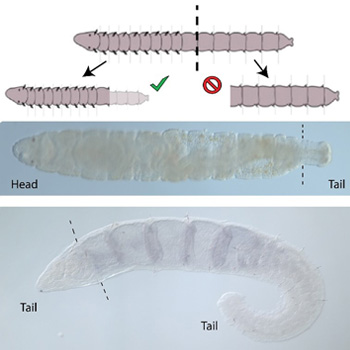
The Seaver Lab published a new paper entitled “Wnt/β-catenin signaling promotes posterior axial regeneration in non-regenerative tissue of the annelid Capitella teleta” in the journal Developmental Biology.
Many animals can robustly regenerate new body parts following injury, but many other animals cannot replace lost tissues.
To understand why regeneration fails in some contexts, Lauren Kunselman and Elaine Seaver studied a segmented marine worm called Capitella teleta. This worm is special because it can regenerate its tail; however, the tail end of the worm cannot regenerate a head even though it can stay alive for about a week.
By comparing the end of the worm that could regenerate to the end of the worm that could not regenerate, Kunselman found that certain hallmarks of regeneration, like cell proliferation and muscle regrowth, were absent in the non-regenerating tail fragments.
However, by activating a cell signaling pathway called the Wnt/ β-catenin pathway, Lauren was able to induce new tissue growth at the cut site in the tail fragments. Surprisingly, instead of growing a head (which was the missing structure), the tissue began forming another tail at the cut site, making a biaxial, or two-tailed, worm!
Overall, this research suggests that regeneration potential can be increased, but the correct signals are needed for cells to make the appropriate missing structure. There is a lot more to learn about regeneration from this marine worm, and the Seaver Lab is enthusiastically designing future experiments to test the limits of regeneration rescue.
The full paper can be found at the following link: https://doi.org/10.1016/j.ydbio.2025.05.017
Images: TOP: Graphic showing regenerative abilities of head fragments and tail fragments of the worm Capitella teleta. MIDDLE: Head fragment of a worm 1 week after cutting at the location indicated by the dotted line. It has regrown a tail. BOTTOM: Biaxial worm tail fragment 1 week after cutting at the location indicated by the dotted line. This animal was treated with a drug that caused it to regenerate another tail.